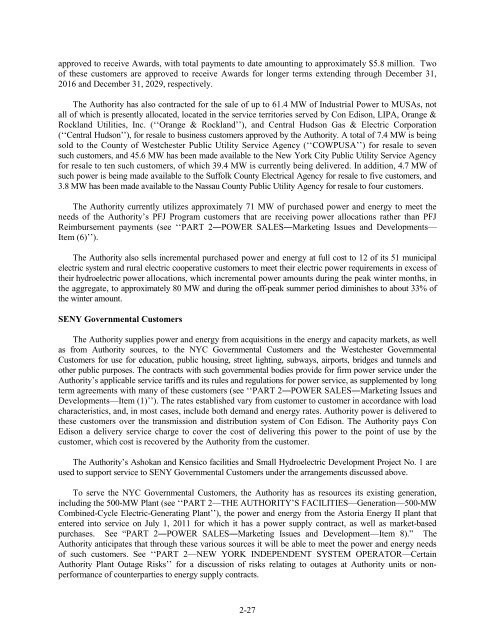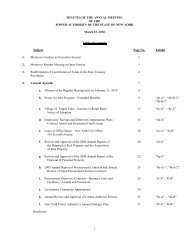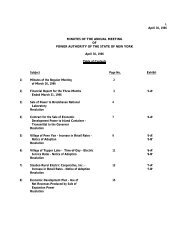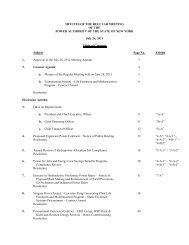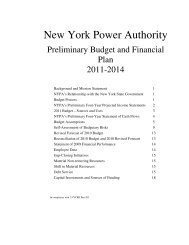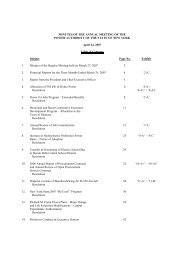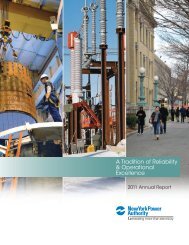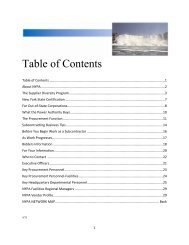July (pdf) - New York Power Authority
July (pdf) - New York Power Authority
July (pdf) - New York Power Authority
Create successful ePaper yourself
Turn your PDF publications into a flip-book with our unique Google optimized e-Paper software.
approved to receive Awards, with total payments to date amounting to approximately $5.8 million. Two<br />
of these customers are approved to receive Awards for longer terms extending through December 31,<br />
2016 and December 31, 2029, respectively.<br />
The <strong>Authority</strong> has also contracted for the sale of up to 61.4 MW of Industrial <strong>Power</strong> to MUSAs, not<br />
all of which is presently allocated, located in the service territories served by Con Edison, LIPA, Orange &<br />
Rockland Utilities, Inc. (‘‘Orange & Rockland’’), and Central Hudson Gas & Electric Corporation<br />
(‘‘Central Hudson’’), for resale to business customers approved by the <strong>Authority</strong>. A total of 7.4 MW is being<br />
sold to the County of Westchester Public Utility Service Agency (‘‘COWPUSA’’) for resale to seven<br />
such customers, and 45.6 MW has been made available to the <strong>New</strong> <strong>York</strong> City Public Utility Service Agency<br />
for resale to ten such customers, of which 39.4 MW is currently being delivered. In addition, 4.7 MW of<br />
such power is being made available to the Suffolk County Electrical Agency for resale to five customers, and<br />
3.8 MW has been made available to the Nassau County Public Utility Agency for resale to four customers.<br />
The <strong>Authority</strong> currently utilizes approximately 71 MW of purchased power and energy to meet the<br />
needs of the <strong>Authority</strong>’s PFJ Program customers that are receiving power allocations rather than PFJ<br />
Reimbursement payments (see ‘‘PART 2―POWER SALES―Marketing Issues and Developments—<br />
Item (6)’’).<br />
The <strong>Authority</strong> also sells incremental purchased power and energy at full cost to 12 of its 51 municipal<br />
electric system and rural electric cooperative customers to meet their electric power requirements in excess of<br />
their hydroelectric power allocations, which incremental power amounts during the peak winter months, in<br />
the aggregate, to approximately 80 MW and during the off-peak summer period diminishes to about 33% of<br />
the winter amount.<br />
SENY Governmental Customers<br />
The <strong>Authority</strong> supplies power and energy from acquisitions in the energy and capacity markets, as well<br />
as from <strong>Authority</strong> sources, to the NYC Governmental Customers and the Westchester Governmental<br />
Customers for use for education, public housing, street lighting, subways, airports, bridges and tunnels and<br />
other public purposes. The contracts with such governmental bodies provide for firm power service under the<br />
<strong>Authority</strong>’s applicable service tariffs and its rules and regulations for power service, as supplemented by long<br />
term agreements with many of these customers (see ‘‘PART 2―POWER SALES―Marketing Issues and<br />
Developments—Item (1)’’). The rates established vary from customer to customer in accordance with load<br />
characteristics, and, in most cases, include both demand and energy rates. <strong>Authority</strong> power is delivered to<br />
these customers over the transmission and distribution system of Con Edison. The <strong>Authority</strong> pays Con<br />
Edison a delivery service charge to cover the cost of delivering this power to the point of use by the<br />
customer, which cost is recovered by the <strong>Authority</strong> from the customer.<br />
The <strong>Authority</strong>’s Ashokan and Kensico facilities and Small Hydroelectric Development Project No. 1 are<br />
used to support service to SENY Governmental Customers under the arrangements discussed above.<br />
To serve the NYC Governmental Customers, the <strong>Authority</strong> has as resources its existing generation,<br />
including the 500-MW Plant (see ‘‘PART 2—THE AUTHORITY’S FACILITIES—Generation—500-MW<br />
Combined-Cycle Electric-Generating Plant’’), the power and energy from the Astoria Energy II plant that<br />
entered into service on <strong>July</strong> 1, 2011 for which it has a power supply contract, as well as market-based<br />
purchases. See “PART 2―POWER SALES―Marketing Issues and Development—Item 8).” The<br />
<strong>Authority</strong> anticipates that through these various sources it will be able to meet the power and energy needs<br />
of such customers. See ‘‘PART 2—NEW YORK INDEPENDENT SYSTEM OPERATOR—Certain<br />
<strong>Authority</strong> Plant Outage Risks’’ for a discussion of risks relating to outages at <strong>Authority</strong> units or nonperformance<br />
of counterparties to energy supply contracts.<br />
2-27


